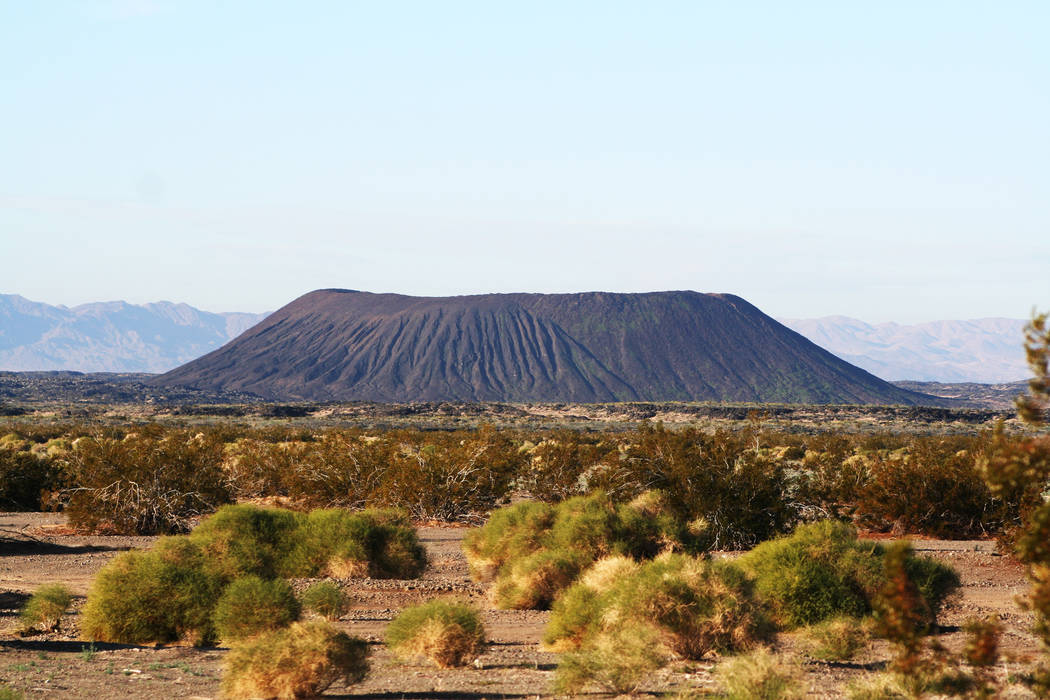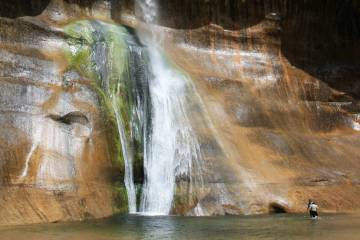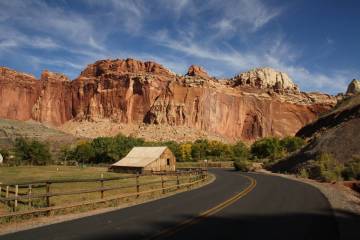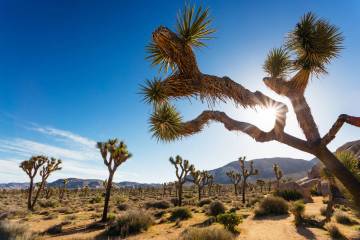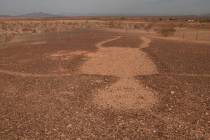Amboy Crater the region’s most picturesque volcano
Now through early spring is the best time for roaming remote desert areas and examining the desert’s interesting and exposed geology. A drive to Amboy Crater offers both! The road trip takes you through the Mojave National Preserve and along historic Route 66 to the tiny town of Amboy, and its nearby volcanic crater.
Be sure to gas up, and bring your own food and beverages on this full-day trip. The crater hike follows a moderate 3-mile round-trip trail, but because of some uneven footing, it’s not recommended for small children.
Inactive volcanoes grace our landscape in all directions, but there are no others so picture perfect as Amboy Crater. Amboy Crater was active perhaps 10,000 years ago, and you can see much evidence of that activity in the 43-square-mile lava field that surrounds it. This is such a good lava field, the Mars Rover was tested here. The crater was formed by at least four eruptions, and once inside the rim you will find four coaxially nested cones.
From the signed trailhead and parking area, at about 670 feet, take the well-worn path southwest toward the crater. From here you might notice what looks like the trail on the north side of the crater, but ignore it; it’s steep and dangerous. Keep to the trail that heads southwest. Be sure to stay on the trail, because you are close to Twentynine Palms Marine Corps Base.
Inside the crater, the walking gets a little more difficult as you skirt lava rocks on uneven terrain, but soon you will find yourself 300 feet higher up on the crater rim. You can walk around the rim, but it is slow going and a chore maneuvering around and on the lava rocks.
The crater is about 1,500 feet in diameter, and there are some wonderful views here. Look toward the north and you will see the Old Dad and Granite mountains in the Mojave National Preserve. To the east are the Old Women Mountains.
The crater is just off Route 66, which used to be the main east-to-west highway to or from California. Even earlier, in 1883, tracks were laid by the Atlantic and Pacific Railroad from Needles, California, to the east and Barstow to the west. In that era of steam locomotives the railroad had to build water stations, which became the principal settlements of this still-remote area. It named them alphabetically, starting in Amboy and continuing east with Bolo, Cadiz, Danby, Essex, Fenner and Goffs. If you travel east along Route 66 you will pass these places, some abandoned. The tracks, now owned by BNSF Railway, carry several trains an hour.
When passenger trains were more common, travelers from the East and Midwest considered Amboy Crater a must-see landmark, for most had never seen a “real volcano.”
In the early 1900s a group of railroad workers from Bagdad, the town directly to the west, played a prank on train passengers. They brought dried plants and other easily flammable materials to the crater. As a passenger train was on its way by, the group lit a smoky fire. The passengers thought they were seeing an active volcano.
Years ago, after I published an article mentioning this episode, a fellow Southern Nevadan wrote to me that he and his buddies had perpetrated a similar hoax in the 1970s. They spent days lugging old tires up to the rim. Once their pile was big enough they set a timer, allowing them to depart and establish credible alibis. When the tires sent up copious amounts of black smoke, tourists and locals started to flee. Once the prank was discovered and the guilty parties revealed, they all received a stern warning. All in a good day’s fun, I say!
But don’t try this now, as the crater now is under the jurisdiction of the U.S. Bureau of Land Management, which would not find the third time charming. I would expect heavy fines and jail time.
Deborah Wall’s book “Base Camp Las Vegas: 101 hikes in the Southwest” ($24.95, Imbrifex) is available on Amazon. She can be reached at deborabus@aol.com.
Directions
From Las Vegas, take Interstate 15 south 47 miles, then take Nipton Road exit, going east. Drive 3 miles and head right onto Ivanpah Road for 3 miles, then turn right onto Morningstar Mine Road. Drive about 15 miles to Cima and stay left onto the Kelso-Cima road. Continue about 14 more miles to the Kelso Depot. Turn left onto Kelbaker Road. Continue south for 32 miles (crossing under Interstate 40) and turn right on Route 66. Drive 7.7 miles and go left into the Amboy Crater access road. Drive a half-mile to parking area and trailhead.



